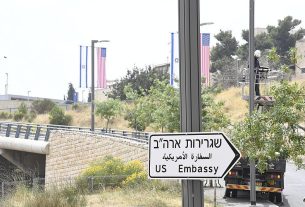Photo Credit: Michael Azband

Mosaic segments depicting bird and animal legs were discovered in the excavation of a synagogue in the ancient settlement of Majdulia, near Natur on the Golan Heights, a Haifa University spokesperson reported Monday. The settlement was probably established at the end of the Second Temple period, in the first century CE, and ceased to exist at the end of the third century.
The findings of the latest excavation season on the site throw new light about the change that took place in the Jewish community during the Roman period.

‘);
_avp.push({ tagid: article_top_ad_tagid, alias: ‘/’, type: ‘banner’, zid: ThisAdID, pid: 16, onscroll: 0 });
“This is the earliest discovery of a colorful and decorated mosaic in a Golan synagogue, dating back to the third century CE, a period about which there is almost no information regarding the Jewish community on the Golan in particular, and few remains of synagogues in Israel in general,” said excavation director Dr. Mechael Osband of the Zinman Institute of Archeology at the University of Haifa.
“In the third century CE, we see an interesting combination of the continued tradition of synagogues from the Second Temple period, such as the seating arrangement and the relative lack of architectural decorations – with new added elements that would later become common in synagogues over time, such as a colorful mosaic that features animals,” Dr. Osband said.

A few years ago, the excavation team found the remains of a synagogue in the settlement, with a rectangular plan measuring 13 by 23 meters. The find was of enormous importance: until a few years ago, the prevailing view in the field suggested Jewish life on the Golan ceased after the Great Revolt, with the destruction of Gamla in 67 CE.
The discovery of the synagogue, together with testimony from other excavations and surveys in recent years, supported the view that the Golan Jewish community continued to exist.
The last excavation season at the synagogue added a new and important level of understanding of the evolution of Jewish life in the area over the years, and about Jewish life in the Golan countryside under Roman rule.
The researchers were able to uncover colored mosaic sections inside the synagogue, with the contribution of Shalom Ariel, who joined the project as part of his graduate studies at Kinneret College. According to the excavation team, without Ariel’s dedication and patience, the structure of the building in general and the mosaic in particular may not have been made accessible.
According to Dr. Osband, only the lower levels of the synagogue survived, and only the mosaic from a few sections remains, probably due to deliberate dismantling of the building over the years.

The exposed mosaic sections indicate that the mosaic floors of the synagogue’s side halls were colored with a wealth of geometric shapes. But the mosaic in the main hall was more complex and rich, and despite its meager state of preservation, bird and animal legs can still be recognized.
According to the researchers, the fact of this rich mosaic design has an important meaning: it may be proof that the synagogue was transformed at some point from a place dedicated almost exclusively to learning, to a place of prayer for the entire local community.
“We know that synagogues at the end of the Second Temple period served mainly as a place of Torah study,” Dr. Osband explained. “Synagogues at the end of the Roman period and especially in the Byzantine period serve as a place for prayer, a kind of ‘little temple,’ which is why they were much more luxurious and it is not uncommon that they also featured fancy mosaics.”
“Our findings are some of the earliest discovered to date, showing that as early as the third century, synagogues were beginning to undergo this important change of awareness,” he concluded.
The excavation is supported by local and foreign volunteers, with help from the Golan Regional Council, the Shamir Institute for Research, and the National Science Foundation.
The main mosaic sections were removed for thorough preservation by the curator Victor Uziel.
‘);
_avp.push({ tagid: article_top_ad_tagid, alias: ‘/’, type: ‘banner’, zid: ThisAdID, pid: 16, onscroll: 10 });



